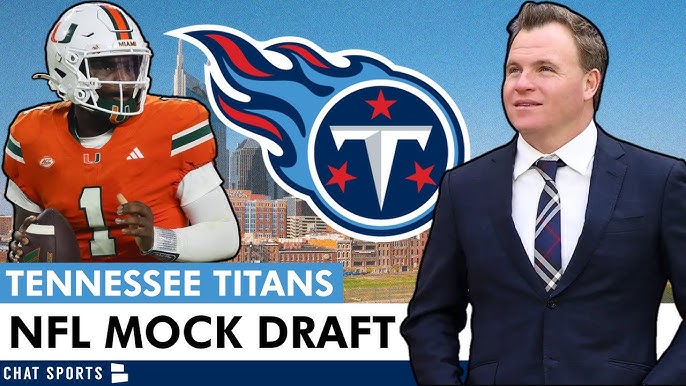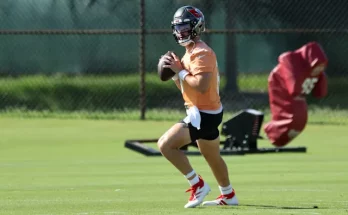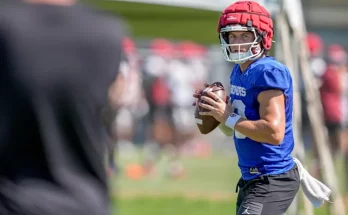Tennessee Titans Decline Giants’ Offer for No. 1 Overall Pick: A Strategic Move
In the high-stakes world of NFL draft maneuvering, decisions made in war rooms can echo for years across franchise history. With the 2025 NFL Draft fast approaching, one of the most headline-grabbing developments to surface is the Tennessee Titans’ decision to decline a trade offer from the New York Giants for the No. 1 overall pick. While on the surface it might seem like a bold refusal of potential assets, the Titans’ decision is more than just a draft-day gamble—it’s a calculated strategic move that signals the organization’s intent to take control of its future.
A Glimpse Into the Giants’ Offer
According to sources close to the situation, the Giants, who currently hold the No. 6 overall pick, were prepared to offer a package that included:
- The No. 6 pick in the 2025 Draft
- A 2025 second-rounder
- A 2026 first-round pick
- Young defensive back Cor’Dale Flott
This package was not insignificant by any means. In fact, by historical standards, the Giants’ offer was comparable to deals like the San Francisco 49ers’ 2021 trade up to land Trey Lance, or even the Rams’ 2016 leap to No. 1 to draft Jared Goff. Yet the Titans held firm, signaling that no package was tempting enough to pry the top selection from their hands.
Why the Titans Are Holding the Line
There are several key reasons why Tennessee’s front office, led by GM Ran Carthon and head coach Brian Callahan, opted to retain the top pick:
1. Quarterback-Centric Future
Even after investing in Will Levis, the Titans clearly aren’t married to the idea that he’s the long-term answer. Rumors have swirled that USC’s Caleb Williams or North Carolina’s Drake Maye remains a top target for Tennessee. With elite traits, high ceilings, and the potential to be Day 1 franchise quarterbacks, either prospect could define the next decade for the Titans.
By holding onto the pick, the Titans have the luxury of choice—not only picking the best quarterback available but selecting the quarterback best suited for Callahan’s offensive vision.
2. Rebuilding With a Cornerstone
Let’s not forget that Tennessee is in the middle of a transformation. Derrick Henry is gone, DeAndre Hopkins is aging, and the offensive line still needs reinforcements. Rather than acquiring multiple mid-tier pieces, the Titans are banking on the notion that one transformative player—especially a quarterback—can accelerate a rebuild far more effectively than a collection of B-grade assets.
3. Fan Base and Market Positioning
The Titans’ fan base has been starved for a superstar at quarterback since the days of Steve McNair. While Ryan Tannehill had moments, and Will Levis showed flashes, neither has ignited the long-term hope that a top-drafted, franchise-altering talent can bring.
Keeping the No. 1 pick helps the Titans sell hope, create buzz, and solidify their brand in a competitive AFC South that includes rising stars like C.J. Stroud, Trevor Lawrence, and Anthony Richardson.
The Giants’ Perspective: Desperation or Boldness?
From the Giants’ angle, the rejected offer was more than a strategic bid—it was a statement of urgency.
1. Daniel Jones’ Diminishing Window
The Giants find themselves in an awkward marriage with Daniel Jones, whose massive contract extension has yet to pay dividends. After a 2024 campaign plagued by turnovers and inconsistency, the Giants’ front office seems ready to move on or at least create internal competition.
Making a play for the No. 1 overall pick signaled their desire to land a premium quarterback like Caleb Williams, perhaps even to push Jones out of the picture altogether.
2. Brian Daboll on the Hot Seat
Just two seasons removed from being hailed a coaching savior, Brian Daboll’s seat is warming. A losing record and stagnating offense have left fans disillusioned. A new quarterback, especially one with star power, could buy the coaching staff time and shift momentum heading into the 2025 season.
3. Big Market, Big Expectations
New York thrives on headlines. A top quarterback would immediately energize the media landscape, fill MetLife Stadium, and restore a sense of direction to a franchise that has struggled to find its identity since Eli Manning retired.
Still, the Giants’ offer—while aggressive—was not enough to move the Titans. And that in itself tells a deeper story.
Historical Context: When Teams Hold the No. 1 Pick
Historically, holding the No. 1 pick is both a privilege and a pressure cooker. Teams in this position often face the temptation to trade down for a haul. Yet those who stay and pick wisely often transform their trajectory:
- Indianapolis Colts (1998): Took Peyton Manning. A franchise-altering decision.
- Carolina Panthers (2011): Drafted Cam Newton. He led them to a Super Bowl.
- Cincinnati Bengals (2020): Stayed put and took Joe Burrow. They’ve been playoff contenders since.
In contrast, some teams that traded down have regretted the decision. The Titans themselves traded the No. 1 pick in 2016 to the Rams, who selected Jared Goff. While the Titans gained assets, their quarterback carousel lasted years longer than it might have with a blue-chip selection.
Clearly, Carthon and company have learned from history. This time, they’re not giving up the golden ticket.
What’s Next for the Titans?
As the draft nears, all eyes will remain on Nashville. The Titans now possess leverage, power, and expectation. Here’s what to watch:
1. Final QB Evaluations
While Caleb Williams is the presumed top choice, there’s still a debate about how he compares to Drake Maye, and even J.J. McCarthy. The Titans are likely doing due diligence, diving deep into interviews, workouts, and psychological profiles.
Brian Callahan, with a quarterback-friendly system, is well-positioned to maximize a young passer, especially if Tennessee continues to build a competent offensive line and adds weapons through the draft.
2. Building Around the Pick
With the No. 1 pick essentially locked in, the Titans can focus their remaining draft assets and free agency capital on building around their new quarterback. Expect them to add:
- At least one wide receiver in the second or third round
- An offensive lineman to protect the future QB
- Depth at EDGE and cornerback to maintain defensive competitiveness
3. Creating a New Identity
Tennessee’s roster is shifting toward youth, versatility, and speed. From defensive playmakers like Harold Landry and Roger McCreary to new offensive additions like Tony Pollard, the Titans seem poised to shift away from the ground-and-pound Derrick Henry era into something more dynamic.
What Does This Mean for the Giants?
The Giants’ rejection will sting, especially if the quarterback they covet turns into a perennial Pro Bowler in Tennessee. But all is not lost:
- Plan B may involve trading up to No. 3 or No. 4, depending on how other quarterback-needy teams draft.
- They may still land Michigan’s J.J. McCarthy or Oregon’s Bo Nix.
- Or, in a more conservative pivot, they may stick with Daniel Jones and draft a wide receiver like Malik Nabers or Marvin Harrison Jr.—giving Jones one final season to prove his value.
Regardless, the Giants will be under pressure to justify their fallback plan, whatever it turns out to be.
Final Thoughts: A Defining Moment for the Titans
Declining a massive trade offer isn’t just about saying “no”—it’s about saying “yes” to your vision.
By holding onto the No. 1 pick, the Titans are staking their future on a yet-unnamed quarterback. They’re betting on their scouting, their coaching, and the belief that one player can alter everything.
It’s risky. It’s bold. But if history has taught us anything, it’s this: sometimes the bravest moves are the ones you don’t make.



